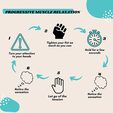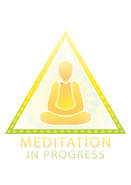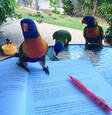 Separating. Other people’s anxiety can rub off on us or we ‘catch’ it from them. We can find ourselves doing a task in a rush or feeling overwhelmed by something because someone else is anxious about that task or they want it done quickly. Ask yourself whether the anxiety you are feeling is yours or whether you have picked it up from someone else. It is a good idea to put this kind of anxiety down or try to avoid accepting it in the first place. You can visualise what their anxiety looks like and visualise putting it down somewhere where it cannot affect you such as on a shelf or in a box. Or you can try physically shaking it off and down your arms until it falls away from you.
0 Comments
Challenging fearful thoughts. We are programmed to think negatively to aid our survival and this can be heightened when in stressful situations. But these thoughts can easily overwhelm us and paralyse us. Try to get curious about these thoughts rather than pushing them away. Monsters tend to grow in size when we don’t turn to face them… Use the Socratic questioning method to find out more about your negative thoughts and to challenge them:
 Working with the situation: We often get stuck in one way of thinking about our problems and situations. This can lead to us repeating patterns of thinking and behaviour which might not serve us very well. Try asking yourself these questions: Avoid – is there anything about this situation I can avoid or say no to? Alter – is there anything about this situation I can change (external changes)? Adapt – is there anything I can change about how I feel/what I think about this situation (internal changes)? Accept – is this something I need to accept by:
 Noticing. This works because it takes us out of the instinctual fight/flight/freeze part of our brain into the noticing/rational part. It is much more difficult to panic if we are busy noticing things around us. Try the 54321 method:
 Anchoring. Sometimes, we just need to feel rooted so that we can be safe. Think of it as anchoring a tent by securely fastening guy ropes and banging tent pegs into the ground or casting an anchor from a boat to hold it steady in the winds and water. You can ground yourself (as in Tip 8) and have a sentence or phrase ready to repeat to yourself to anchor you in the here and now. You can adapt any sentence which makes you feel secure. For example, ‘It’s (insert time) on (insert day) and I am (insert location). I am safe. Holding something like a stone or a small favourite ornament or picture can really help to anchor you too.  Grounding. Making sure we are firmly in our physical bodies rather than lost in thoughts in our heads can help us to feel safe and secure. Sit down and place your feet flat on the floor. Notice how the floor supports your feet and the chair supports your seat bones and back. Try to feel yourself solidly into your body. Keep your eyes open as it is easier to stay connected to what is solidly around you. You can pair this up with anchoring and noticing (see tips 9 and 10).  Muscle relaxation. At times, we hold parts of our body tensely and this can be exhausting. We may get so used to doing this that we don’t consciously notice until we are in pain. Work all around your body:
 Meditation. Our brains are plastic which means we can change what we think and feel by reorganising how we think or making new connections between ideas. We can also learn new things. Meditation can be used for relaxation and calming purposes but it also gives us a way of training our brains so that we are in charge of what we think and are less likely to be derailed by difficult thoughts or negative ways of thinking. Find somewhere warm, quiet and comfortable to sit or lie. Use the breathing techniques from earlier tips to breathe deeply and evenly. Then notice what thoughts come into your mind and what emotions are attached to them. Practise letting these thoughts go rather like a car which drives past and then is out of sight or a balloon that blows across the sky in front of you. When you come across thoughts which trouble you and are hard to let go of, you could try working with them (Tip 11) or challenging them (Tip 12). Come up with your own meditations or use Apps such as Calm, Heartfulness or Headspace  Visualising. Sometimes, like being in the middle of a pandemic, we just cannot engineer being in a safe place. Everything around us feels wrong and out of control and fixing it is beyond our capabilities. When you feel emotionally unsafe, it can be really helpful to have somewhere inside yourself to escape to. Pick your safe place and learn to visualise every detail of it so that you can go there in your imagination if you need to. It should be somewhere that is utterly safe and secure to you. Think about all your senses when imagining it. You can also people it with those friends and/or family who you feel totally safe with.  Distraction. When we get stuck in difficult or unpleasant patterns of thoughts, feelings or behaviours, it can be useful to distract ourselves for a while. It might help to make a list of things that really work well for you as distractions so that you have a variety of ones to choose from. Distraction can take the form of reciting a poem or song you know off by heart or by counting things such as times tables or counting backwards from 100. My favourite distraction game is to pick a topic such as dog breeds and go through the alphabet: Afghan, Beagle, Cocker Spaniel, etc. |
AuthorHello! My name is Lizzie and I work as a counsellor in Surrey. Archives
October 2022
Categories |
 RSS Feed
RSS Feed
